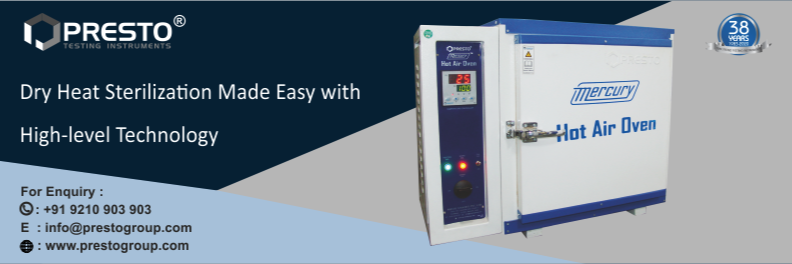

Sterilization can be defined as any process that effectively kills or eliminates transmissible agents (such as fungi, bacteria, viruses and prions) from a surface, equipment, foods, medications, or biological culture medium. In practice sterility is achieved by exposure of the object to be sterilized to chemical or physical agent for a specified time. Various agents used as steriliants are: elevated temperature, ionizing radiation, chemical liquids or gases etc. The success of the process depends upon the choice of the method adopted for sterilization. In this post we will be focusing on the Dry heat sterilization method using Hot Air Oven.
Dry heat sterilization can only be used for thermostable, moisture sensitive or moisture impermeable pharmaceutical and medicinal. These include products like; Dry powdered drugs, Suspensions of drug in non-aqueous solvents, Oils, fats waxes, soft hard paraffin silicone, Oily injections, implants, ophthalmic ointments and ointment bases etc.
Examples of Dry heat sterilization are:
1. Incineration
2. Red heat
3. Flaming
4. Hot air oven
It employs higher temperatures in the range of 160-1800°C and requires exposures time up to 2 hours, depending upon the temperature employed. The benefit of dry heat includes good penetrability and non-corrosive nature which makes it applicable for sterilizing glasswares and metal surgical instruments. It is also used for sterilizing non-aqueous thermostable liquids and thermostable powders. Dry heat destroys bacterial endotoxins (or pyrogens) which are difficult to eliminate by other means and this property makes it applicable for sterilizing glass bottles which are to be filled aseptically.
Hot-air oven
Dry heat sterilization is usually carried out in a hot air oven, which consists of the following:
Operation
Articles to be sterilized are first wrapped or enclosed in containers of cardboard, paper or aluminum. Then, the materials are arranged to ensure uninterrupted air flow. Oven may be pre-heated for materials with poor heat conductivity. The temperature is allowed to fall to 400°C, prior to removal of sterilized material.
Presto brings a unique test cabinet designed to detect the change in the physical characteristics of the material and to ascertain the actual working life of testing device at elevated temperature. Works on Forced air circulation, thermal convection principle, suitable for Tests like heat deformation, compression set, heat resistance required in rubber and plastic industries.
To know more information about its features, price, and technical specifications, give us a call at +91 9210903903 or email us at info@prestogroup.com.
Related Blogs

Hot Air Oven uses dry heat for sterilizing glassware and metal tools, while an Autoclave uses steam under pressure—ideal for liquids and medical items.

GSM of fabric (Grams per Square Meter) indicates fabric weight and thickness. Higher GSM means denser, heavier fabric; lower GSM means lighter, thinner fabric.

Discover why abrasion resistance is crucial for packaging, textiles & plastics. Learn how it's tested (Martindale, Taber, DIN) & why it boosts durability. Save costs with wear-resistant materials!